Choosing the right flooring for a log cabin isn't just about finding something that looks good—it's about harmonizing the material with your unique style. Whether nestled in a forest, perched on a mountain, or situated by a serene lake, log cabins evoke a sense of rustic charm and cozy warmth. Incorporating custom log cabin materials can further enhance this natural aesthetic, ensuring every element, even down to the flooring, aligns with the overall design.
From classic hardwoods to modern composites, the options are diverse. Each material offers unique textures and colors that can complement the rugged beauty of a log cabin while providing practical benefits. As homeowners explore their choices, they'll find that the right flooring not only stands up to the cabin lifestyle but also serves as a foundational element of their decor, setting the tone for memorable gatherings and peaceful retreats.
Popular Flooring Materials for Log Cabins
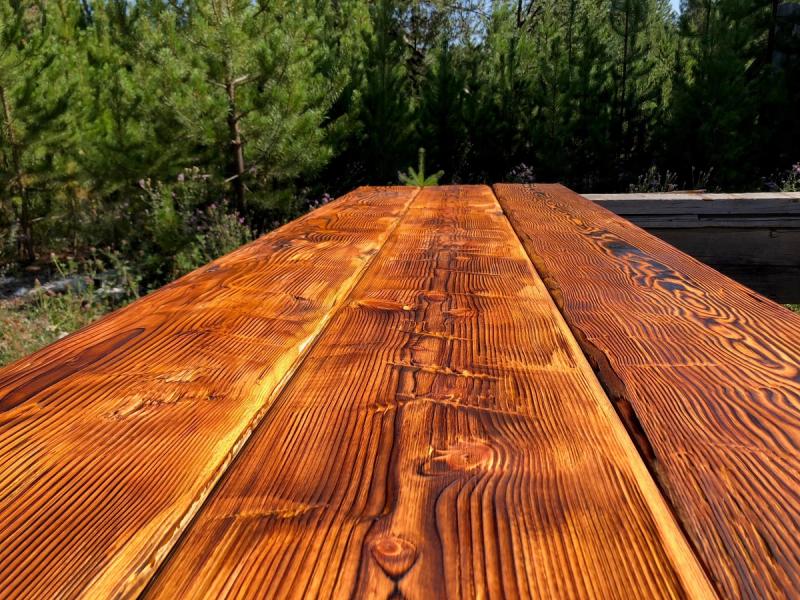
Choosing the right flooring for a log cabin extends its rustic charm and underscores its durability. It also ensures the cabin remains a cozy retreat for its dwellers. The following flooring materials are not only aesthetically aligned with a cabin's rugged, natural vibe but are chosen for their robustness and ease of maintenance.
Hardwood Flooring
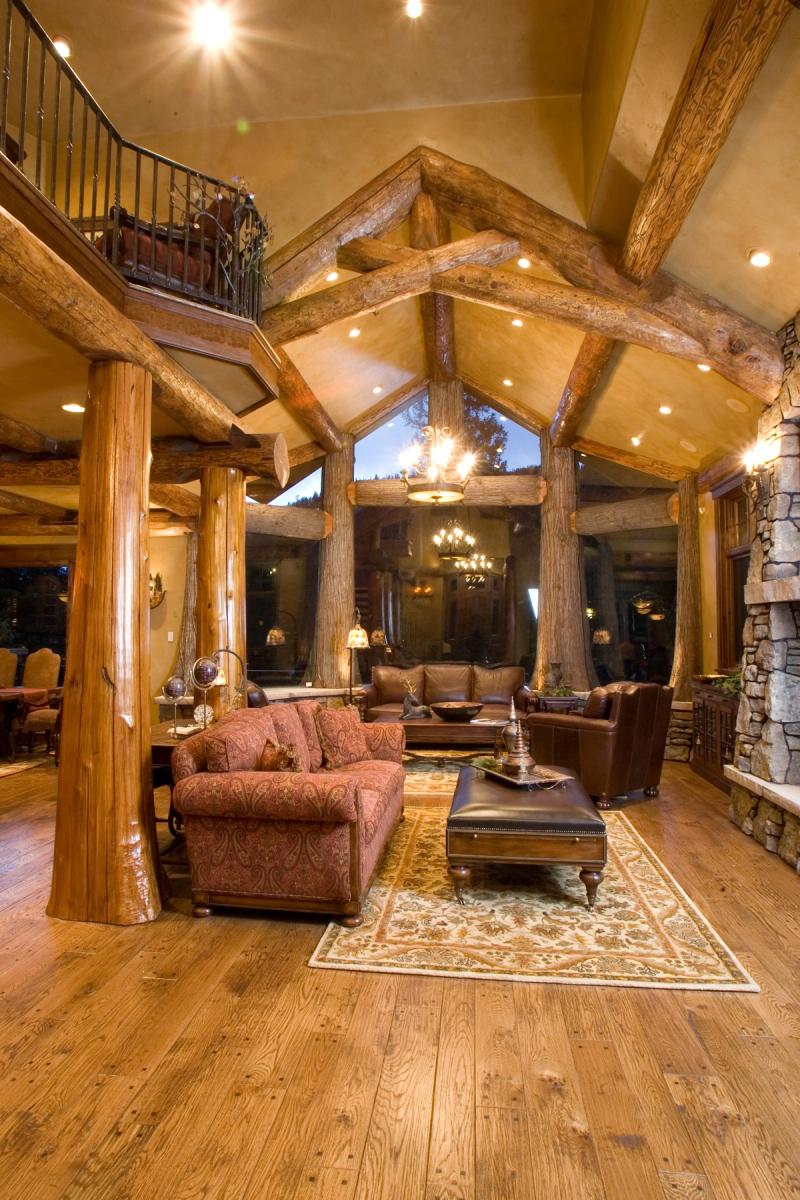
Thanks to their enduring appeal and robust nature, hardwood floors are a top choice for log cabins. Due to their grain patterns and natural colors, species like oak, maple, and hickory complement the rustic log cabin flooring ethos. Hardwood flooring also stands out for its ability to withstand heavy foot traffic, making it ideal for cabins that host frequent gatherings. Its longevity is a significant asset, as hardwood floors can last for decades when properly maintained.
Reclaimed Wood
Reclaimed wood floors offer distinct environmental and aesthetic benefits. This material, salvaged from old buildings, barns, and industrial warehouses, brings a piece of history and an extra layer of character to a cabin. Each plank tells a unique story, making reclaimed wood an ideal match for homeowners seeking a unique, rustic feel. Moreover, reclaimed wood is an environmentally friendly flooring option because it reuses existing wood.
Bamboo Flooring
Bamboo flooring is an excellent alternative for log cabin owners looking for sustainability combined with modern aesthetics. Known for its strength and durability, bamboo rivals traditional hardwoods while being more renewable. It grows rapidly, reaching maturity in about seven years, compared to decades for hardwood trees. Bamboo's light color can brighten cabin interiors, contrasting darker, traditional log cabin features while maintaining an earthy feel.
Tile and Stone Options
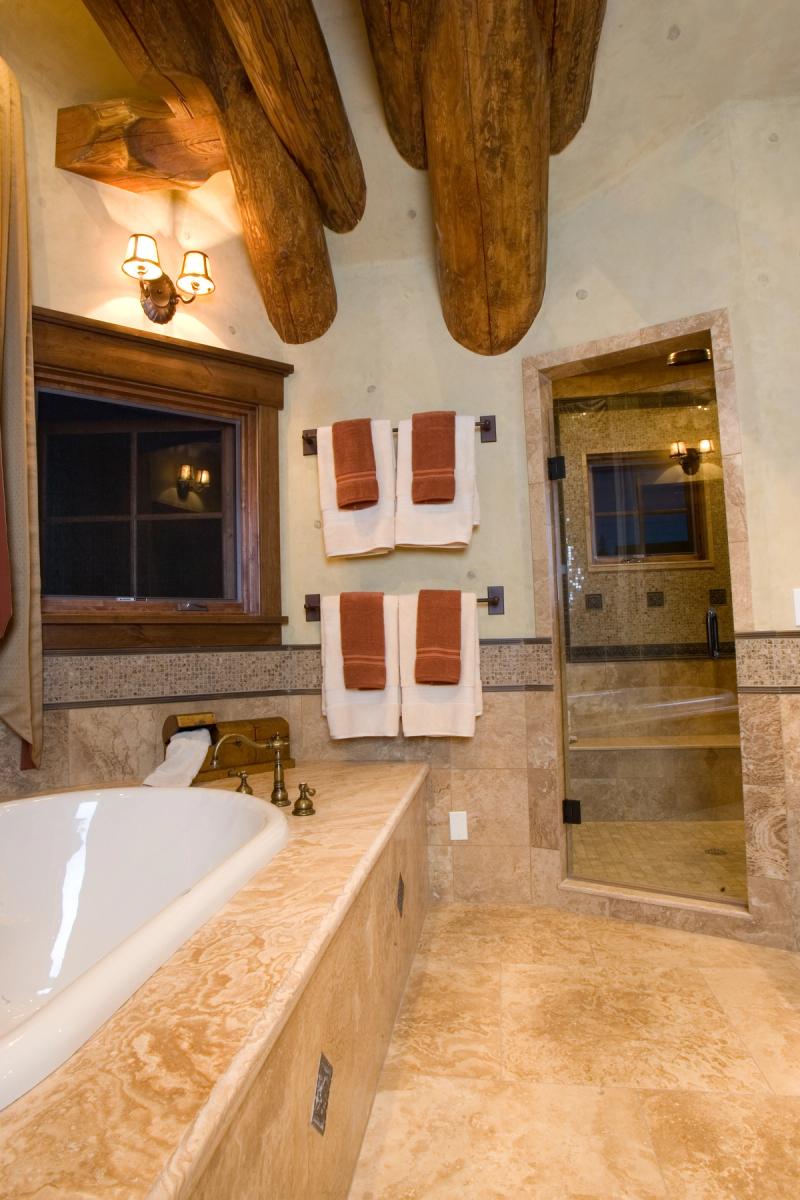
Tile and stone flooring bring versatility and natural beauty to log cabins. Slate, travertine, and marble are popular choices, each adding a unique texture and color variance that complements the natural wood elements of a cabin. These materials are especially favorable in entryways, kitchens, and bathrooms where moisture resistance is crucial. Stone floors are known for their longevity and ease of cleaning, making them a practical choice for high-traffic areas in a cabin.
Sustainable and Eco-Friendly Choices
Exploring sustainable and eco-friendly flooring options enriches log cabins' aesthetic and ethical appeal. Choices like cork and marmoleum support environmental sustainability and bolster the cabin's rustic charm. These materials complement previous sections on durability and practicality, providing complete solutions for upscale log cabin flooring needs.
Cork Flooring
Cork flooring is an excellent eco-friendly option for log cabins due to its remarkable sustainability and aesthetic versatility. Harvested from the bark of cork oak trees, which regenerates every nine years, cork offers a highly renewable resource. Its installation in a log cabin ensures a soft, cushioned feel underfoot, an aspect cherished in residential settings. Cork also provides natural insulation, providing a more thermally efficient cabin environment. The material absorbs sound, making it ideal for maintaining the peaceful ambiance of log cabin settings. Aesthetically, cork can be finished in various stains and textures, easily integrating into a cabin's rustic or modern interiors. Importantly, its anti-microbial properties also make cork a health-conscious choice.
Marmoleum
Marmoleum, recognized for its robust eco-credentials, is a practical and sustainable flooring solution suitable for log cabins. Composed primarily of natural materials like linseed oil, rosin, and limestone, marmoleum is a bio-based product that introduces no harmful VOCs (Volatile Organic Compounds) into the cabin environment. This characteristic is vital for maintaining the indoor air quality of log cabins, which often serve as retreats from urban pollutants. Marmoleum's versatility extends to its vast array of color and pattern choices, ensuring compatibility with various traditional and contemporary design aesthetics. Additionally, it boasts inherent anti-bacterial properties and is easy to clean, making it an excellent option for cabins frequented by guests and families. Its durability is well against the wear and tear typical in high-traffic areas, aligning longevity with ecological responsibility.
Innovative Flooring Alternatives
Wood-Look Options
Innovative wood-look options cater to those who adore the timeless appearance of wood without the upkeep associated with traditional hardwood floors. Luxury vinyl tile (LVT) and laminate are at the forefront of these alternatives. LVT offers superior durability and moisture resistance, making it suitable for log cabins where foot traffic and environmental exposure are constant concerns. Designs in LVT effectively mimic various wood types ranging from classic oak to exotic teak, providing aesthetic flexibility. Laminate, on the other hand, presents a cost-effective solution with substantial resilience and an easy installation process. Notably, laminate flooring can achieve a look similar to rustic log cabin flooring by replicating the intricate textures and tones of reclaimed wood, ensuring a harmonious blend with the cabin's natural surroundings. When combined with large window walls, these wood-look options can create a sense of spaciousness and openness.
Fiber Flooring
Moving beyond conventional materials, fiber flooring such as sisal and jute introduces an eco-friendly touch to log cabins, aligning with modern sustainability trends. These materials, derived from natural fibers, bring warmth and texture into the interior design. They are particularly appreciated for their low environmental impact and biodegradability. Sisal and jute rugs are notably durable and complement the rustic aesthetic of log cabins, reinforcing the connection with nature. These fiber options are also excellent for layering over other flooring types, such as marmoleum, to add visual interest and tactile contrast. Care and maintenance for fiber flooring are straightforward, typically requiring regular vacuuming and occasional spot cleaning to maintain their pristine condition.
Carpeting and Rugs for Warmth
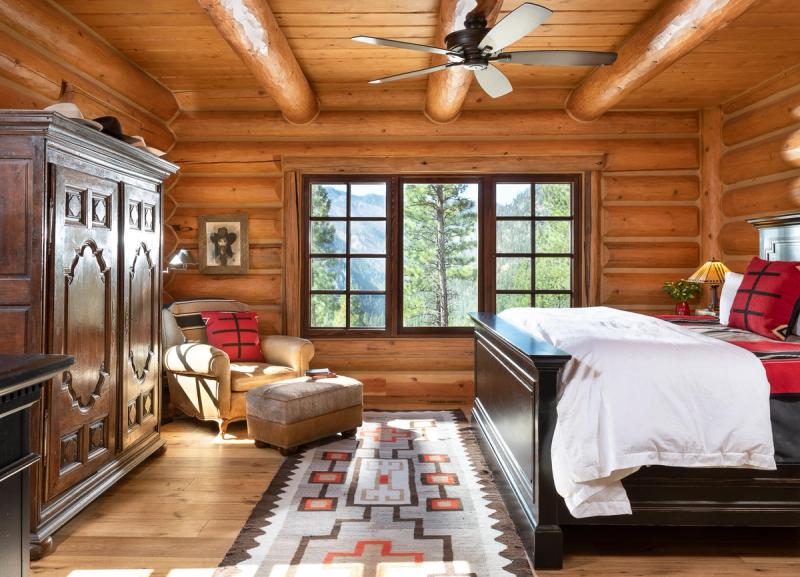
Carpeting and rugs stand out among the flooring options for log cabins for their ability to add warmth and comfort. This section builds on previous discussions of durability and aesthetic alignment with nature, introducing soft floor coverings as the next logical step for enhancing a cabin's cozy atmosphere.
Choosing the Right Carpet
When choosing the perfect carpet for a log cabin, it's important to balance aesthetics with functionality, especially given the unique environmental demands of these homes. Beyond just the visual appeal, the right carpet can contribute to your cabin's overall comfort and energy efficiency. Here are some key factors to consider:
- Material Matters: Wool carpets maximize warmth and provide lasting comfort.
- Density and Weight: A dense carpet pile ensures better insulation and a luxurious feel underfoot.
- Color and Pattern: Darker colors or rustic patterns complement the cabin’s natural aesthetics and help hide dirt.
Incorporating Rugs
Rugs not only provide aesthetic appeal but also contribute to the functional layout of your space. By thoughtfully incorporating rugs into your design, you can create defined areas within larger rooms and enhance the overall ambiance. Here are some key considerations for using rugs in your cabin:
- Strategic Placement: Rugs work well in seating areas or under tables to define spaces and add comfort.
- Texture Variety: Options like shag, woven, or braided rugs introduce diverse textures that enhance the rustic cabin feel.
- Eco-friendly Choices: Natural fiber rugs, such as those made from jute or sisal, align with the sustainable themes evident in modern cabin designs.
Both carpeting and rugs are vital elements in crafting a warm, inviting interior for log cabins. Their inclusion complements the rustic log cabin flooring theme, reinforcing the connection to natural beauty while providing practical benefits like warmth and noise reduction. This choice ensures the cabin's interior is aesthetically pleasing and functionally sound, meeting the needs of homeowners and architects aiming for both comfort and style.
Choosing the Right Flooring
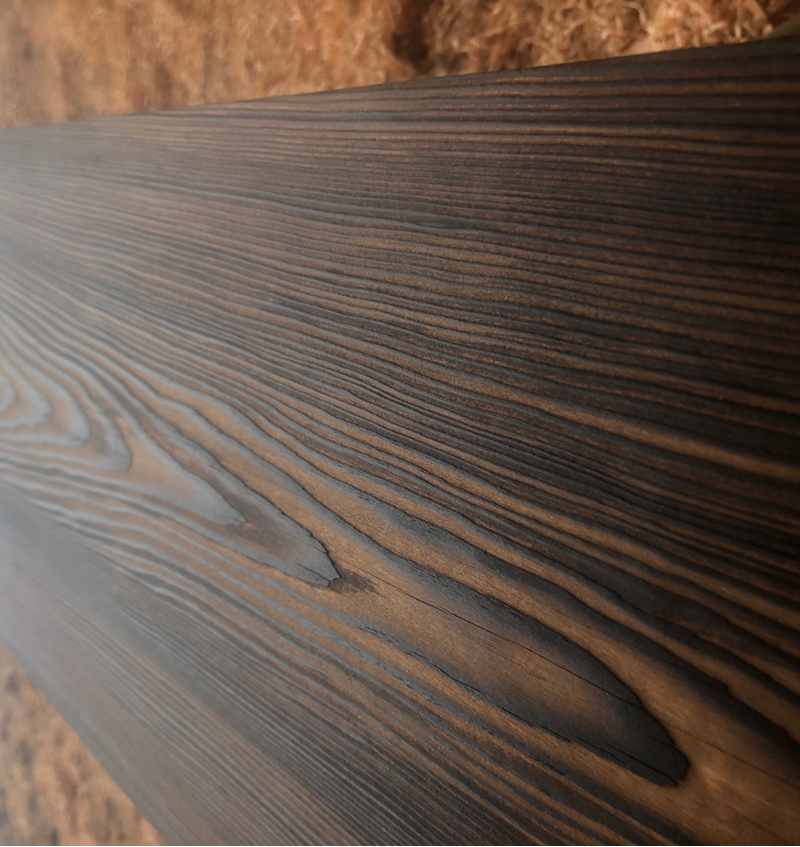
When selecting flooring for a log cabin, it’s essential to consider both the functional and aesthetic aspects to ensure that it complements the rustic charm and meets the cabin's practical needs.
Durability and Maintenance
Choosing flooring that stands the test of time while requiring minimal upkeep is crucial for log cabins, which are often situated in environments that may contribute to wear and tear. Here are a few options that balance durability with easy maintenance:
- Hardwood: Known for its strength, hardwood can endure the heavy foot traffic common in log cabins. Finishing hardwood with a high-quality sealant can further enhance its durability and resistance to moisture and scratches.
- Luxury Vinyl Tile (LVT): LVT offers a wood-look aesthetic and exceptional durability. It's highly resistant to moisture, scratches, and stains, making it ideal for areas like kitchens or bathrooms in log cabins.
- Tile: Ceramic or stone tiles are excellent for log cabins due to their longevity and ease of maintenance. They're also ideal in climates that experience significant temperature shifts, as they handle thermal expansion well.
Aesthetic Considerations
The flooring should be robust and harmonize with the rustic and natural ambiance of a log cabin. Here are aesthetic considerations to keep in mind:
- Rustic Log Cabin Flooring: Utilizing reclaimed wood not only imbues a space with historic significance and uniqueness but also supports environmental sustainability. Its weathered look complements the rustic decor typical of log cabins.
- Color and Texture: Choose flooring colors that echo the natural surroundings. Earth tones, grays, and muted greens blend seamlessly with the cabin setting. Textured options like hand-scraped hardwood or distressed LVT can enhance the floor's rustic feel.
- Consistency: Ensure the flooring type contributes cohesively to the cabin's overall design theme. A wooden floor could amplify this architectural style if the cabin features prominent woodwork and exposed beams, creating a seamless aesthetic flow from wall to floor.
Selecting the right flooring involves considering its ability to withstand cabin conditions and its effect on the overall aesthetic, ensuring it meets both practical functionalities and design expectations.
Conclusion
Choosing the right flooring for a log cabin is crucial to maintaining its charm and functionality. With options ranging from the durability of hardwoods and LVT to the eco-friendly appeal of cork and sisal, every choice reflects a commitment to sustainability and style. Whether it’s the warmth of carpeting or the rustic feel of reclaimed wood, the perfect flooring solution enhances the cabin's aesthetic while ensuring it remains a cozy retreat. Remember to balance practicality with style to create an inviting and enduring space.
Project Management
Lead Designer & CAD Technician
After graduating with a Master's Degree in Wood Engineering, Milan started his career by traveling abroad to apprentice with Brian Schafer, Principal of Big Cabin. As an expert in the industry for over a decade now, his passion for log and timber home construction grew deeply throughout his career and ingrained his knowledge of drafting, project management, and roofing design.